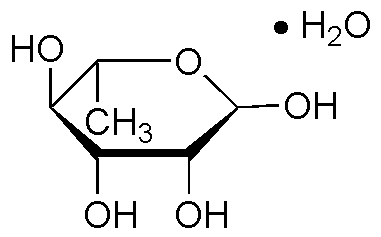6-Deoxy-L-mannose monohydrate is widely utilized in research focused on:
- Pharmaceutical Development: This compound serves as a key building block in the synthesis of various pharmaceuticals, particularly in the development of glycosylated drugs that enhance bioavailability and efficacy.
- Biotechnology: It plays a crucial role in the production of glycoproteins and other biomolecules, which are essential for vaccine development and therapeutic proteins.
- Food Industry: Used as a functional ingredient in health supplements, it may support gut health by acting as a prebiotic, promoting beneficial bacteria growth.
- Cosmetic Formulations: Its moisturizing properties make it a valuable addition to skincare products, helping to improve skin hydration and texture.
- Research and Development: In academic settings, it is utilized in studies related to carbohydrate chemistry and metabolic pathways, providing insights into cellular processes.
General Information
Properties
Safety and Regulations
Applications
6-Deoxy-L-mannose monohydrate is widely utilized in research focused on:
- Pharmaceutical Development: This compound serves as a key building block in the synthesis of various pharmaceuticals, particularly in the development of glycosylated drugs that enhance bioavailability and efficacy.
- Biotechnology: It plays a crucial role in the production of glycoproteins and other biomolecules, which are essential for vaccine development and therapeutic proteins.
- Food Industry: Used as a functional ingredient in health supplements, it may support gut health by acting as a prebiotic, promoting beneficial bacteria growth.
- Cosmetic Formulations: Its moisturizing properties make it a valuable addition to skincare products, helping to improve skin hydration and texture.
- Research and Development: In academic settings, it is utilized in studies related to carbohydrate chemistry and metabolic pathways, providing insights into cellular processes.
Documents
Safety Data Sheets (SDS)
The SDS provides comprehensive safety information on handling, storage, and disposal of the product.
Product Specification (PS)
The PS provides a comprehensive breakdown of the product’s properties, including chemical composition, physical state, purity, and storage requirements. It also details acceptable quality ranges and the product's intended applications.
Certificates of Analysis (COA)
Search for Certificates of Analysis (COA) by entering the products Lot Number. Lot and Batch Numbers can be found on a product’s label following the words ‘Lot’ or ‘Batch’.
Numéro de catalogue
Numéro de lot/série
Certificates Of Origin (COO)
This COO confirms the country where the product was manufactured, and also details the materials and components used in it and whether it is derived from natural, synthetic, or other specific sources. This certificate may be required for customs, trade, and regulatory compliance.
Numéro de catalogue
Numéro de lot/série
Safety Data Sheets (SDS)
The SDS provides comprehensive safety information on handling, storage, and disposal of the product.
DownloadProduct Specification (PS)
The PS provides a comprehensive breakdown of the product’s properties, including chemical composition, physical state, purity, and storage requirements. It also details acceptable quality ranges and the product's intended applications.
DownloadCertificates of Analysis (COA)
Search for Certificates of Analysis (COA) by entering the products Lot Number. Lot and Batch Numbers can be found on a product’s label following the words ‘Lot’ or ‘Batch’.
Numéro de catalogue
Numéro de lot/série
Certificates Of Origin (COO)
This COO confirms the country where the product was manufactured, and also details the materials and components used in it and whether it is derived from natural, synthetic, or other specific sources. This certificate may be required for customs, trade, and regulatory compliance.


